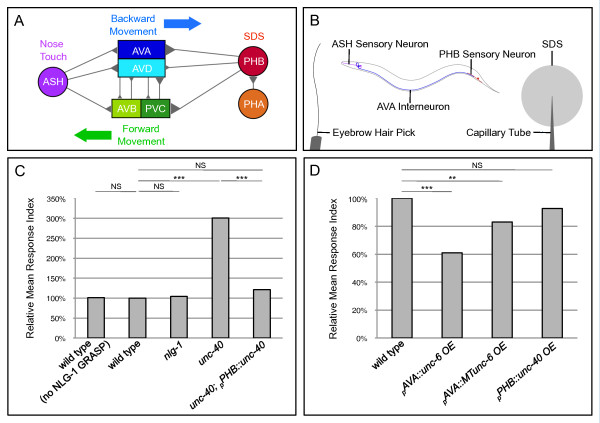Figure 5.
A PHB circuit-specific behavioral assay indicates that UNC-40 and UNC-6 mediate formation of functional synapses. (A) Neural circuit diagram summarizing synaptic contacts between neurons in PHB and ASH sensory circuits. (B) Behavioral assay outline. Function of the PHB circuit is tested by stimulating ASH neurons. ASH-AVA synapses control backward movement induced by a nose touch with an eyebrow hair pick, and PHB-AVA synapses control termination of backwards movement in response to the noxious chemical SDS. (C) Neither the NLG-1 GRASP marker nor mutations in nlg-1 affect SDS sensitivity. However, unc-40 mutants fail to respond to SDS, indicating complete loss of PHB-circuit function. Cell-autonomous expression of unc-40 in PHB neurons rescues the behavioral defect. unc-6 animals are too uncoordinated to be examined with this assay. Two lines were examined for each transgene; in all cases, both lines gave similar results. Wild-type n = 200, wild-type (no NLG-1 GRASP) n = 40, nlg-1 n = 40, unc-40 n = 40, unc-40; pPHB::unc-40 n = 80 animals. ***P < 0.001, NS, not significant, t-test. P-values were adjusted for multiple comparisons using the Hochberg method. (D) Overexpression of unc-6 and MTunc-6 in AVA neurons potentiates the behavioral response while overexpression of unc-40 in PHB does not, indicating that UNC-6 is limiting. Two lines were examined for each transgene with the exception of pPHB::unc-40 overexpression, where three lines were examined; in all cases, all lines gave similar results. Wild-type n = 200, pAVA::unc-6 overexpression n = 80, pAVA::MTunc-6 overexpression n = 80, and pPHB::unc-40 overexpression n = 80 animals. ***P < 0.001, **P < 0.01, NS, not significant, t-test. P-values were adjusted for multiple comparisons using the Hochberg method.

